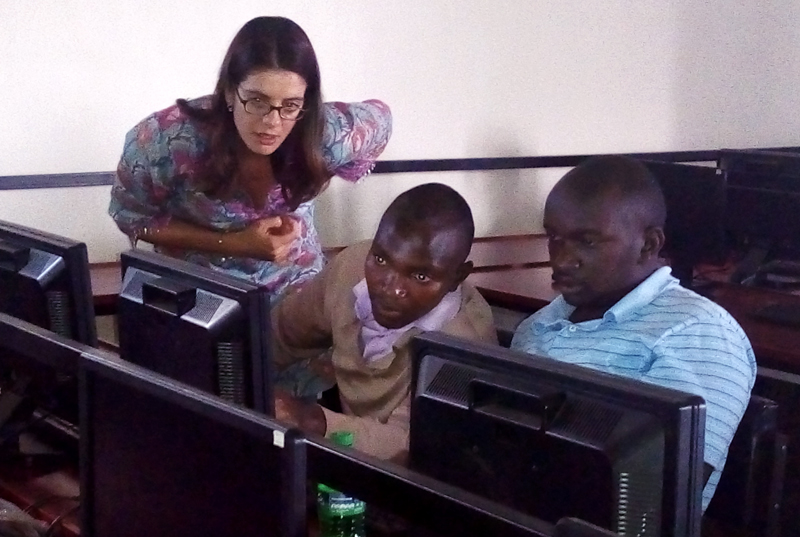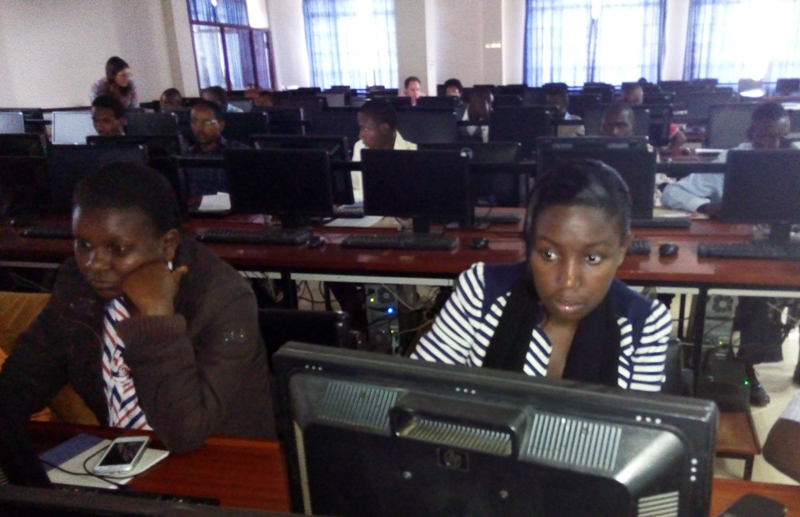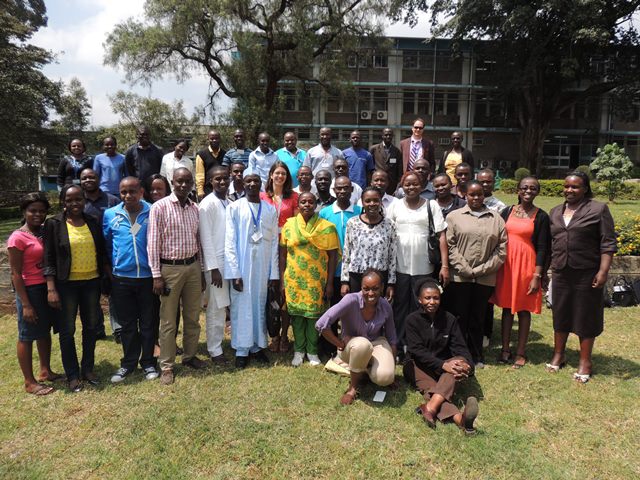Bringing structural chemistry to Kenya
The IUCr-UNESCO-CCDC OpenLab Kenya entitled “An Introduction to Computational Chemistry and In-Silico Visualization. A Workshop for Sub-Saharan Africa Scientists” took place at Kenyatta University and at the University of Nairobi in Kenya during the week of September 7th-11th, 2015, organised by Dr Juliette Pradon of the Cambridge Crystallographic Data Centre (CCDC) and Dr Lewis Whitehead of the Novartis Institute of BioMedical Research, with the local support of Dr Evans Changamu from Kenyatta University and Dr Solomon Derese from the University of Nairobi. Dr Patricia Gitari (The d-orbital Ltd), formerly at Kenyatta University and member of the committee for the African Crystallographic Association, was the local representative of the IUCr.
Nearly 90 attendees, with a range of nationalities (including Kenyan, Nigerian, Eritrean, Ethiopian, Ugandan and Congolese), backgrounds (chemistry, physics, biology) and levels (MSc, PhD and postdoctoral students; university lecturers; academic, governmental and industrial researchers) were introduced to molecular modelling in structural chemistry, medicinal chemistry and drug discovery.
I had a great experience and an awesome time during the OpenLab. The facilitators (Dr Pradon and Dr Whitehead) were really good, natural and had vast knowledge. It was a golden chance to receive some training on subjects not covered by our academic curriculum and to refresh some concepts. I also learnt about other databases such as CrystMet and ICSD. Dr Gitari gave a presentation about the IUCr, its activities and IYCr2014, which were previously unknown to me. I gained a lot of knowledge, which will be vital in my research work (especially the Acta journals) and my future chemistry endeavours.
In my project, I seek to develop a water purification material from siliceous (clay) nanoparticles. As maybe one university in Kenya has an XRD machine - and the chances are that it is not functioning - I had to source the XRD services from a geology company, which was very costly and meant I had limited access to the machine. I feel that the IUCr can make a great impact in the development of crystallography in Kenya by holding more OpenLabs, helping universities and other learning institutions to acquire X-ray diffractometers, providing access to XRD data interpretation software, encouraging universities to include crystallography in their curricula and funding postgraduate projects.
David Marikah (chemistry masters student, Jomo Kenyatta University of Agriculture and Technology, Juja, Kenya), participant The Cambridge Structural Database (CSD), which is the world’s repository for organic and organometallic small-molecule crystal structures, was introduced by Dr Juliette Pradon, as well as the software suite, which allows its 800,000 crystal structures to be accessed, searched and analysed. Dr Solomon Derese raised awareness of the Mitishamba database and its relevance to Kenya and beyond, inviting all to contribute their natural products where possible. Participants learned how to search the CSD, from simpler text/numeric searches to more advanced substructure searches; how to analyse the search results numerically and graphically; how to visualise molecules and investigate their packing arrangements; and how to analyse the intramolecular geometry of molecules and their intermolecular interactions using the knowledge base afforded by the wealth of quality crystal structures in the CSD. These sessions demonstrated how such crystallographic databases have value not only for research but also for teaching purposes. The teaching dataset of the CSD proved to be a particularly useful resource for lecturers to visually illustrate key structural chemistry concepts such as stereochemistry, aromaticity, hapticity, VSEPR molecular shapes and ring conformations for the benefit of their undergraduate students.
The Cambridge Structural Database (CSD), which is the world’s repository for organic and organometallic small-molecule crystal structures, was introduced by Dr Juliette Pradon, as well as the software suite, which allows its 800,000 crystal structures to be accessed, searched and analysed. Dr Solomon Derese raised awareness of the Mitishamba database and its relevance to Kenya and beyond, inviting all to contribute their natural products where possible. Participants learned how to search the CSD, from simpler text/numeric searches to more advanced substructure searches; how to analyse the search results numerically and graphically; how to visualise molecules and investigate their packing arrangements; and how to analyse the intramolecular geometry of molecules and their intermolecular interactions using the knowledge base afforded by the wealth of quality crystal structures in the CSD. These sessions demonstrated how such crystallographic databases have value not only for research but also for teaching purposes. The teaching dataset of the CSD proved to be a particularly useful resource for lecturers to visually illustrate key structural chemistry concepts such as stereochemistry, aromaticity, hapticity, VSEPR molecular shapes and ring conformations for the benefit of their undergraduate students.
An introduction to modelling in drug discovery was also given, focusing on the hit identification phase and demonstrating the usefulness of computers in this field and the range of modelling techniques applicable to specific problems. Participants also had the opportunity to hear from Dr Lewis Whitehead about several past challenges in medicinal chemistry and to themselves apply the CSD System to these challenges.

Finally, Dr Patricia Gitari, as the local representative of the IUCr, raised awareness among the participants of the various past and future IUCr activities in the world and more particularly in Africa. The feedback from participants of this OpenLab was very positive, with many enthusing that they wished it was longer. Looking ahead, future editions of this workshop in East Africa would benefit greatly from having a practical session on a powder and single-crystal diffractometer, and a broader crystallographic education session to help participants understand how structures deposited in the CSD are solved. Once technical expertise on diffractometers has been formed locally, it would be of great benefit to establish a regional centre of diffraction studies, open to all Kenyan and regional institutions, where diffractometers would be available to solve crystal structures. The formation of an African Crystallography Association, once Kenya and other African nations become a member country of the IUCr – as Cameroon has recently done and others surely will do after the first Pan-African Crystallography Conference to be held in Cameroon next year – will shape the advancement of crystallography in Africa and contribute to its recognition as benefiting the entire continent.
Juliette Pradon, CCDC
Patricia Gitari, The d-orbital Ltd
Visit the homepage of the OpenLab Kenya | See a photo album on facebook



